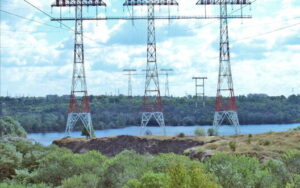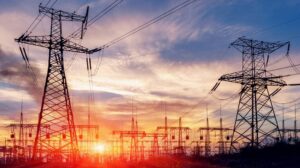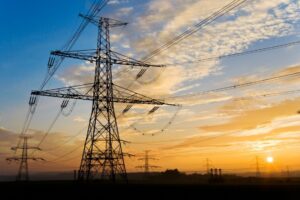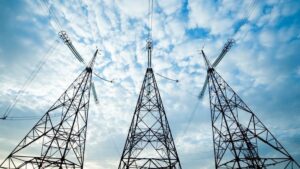
The volume of electricity imports from Slovakia rose 27.3 percent on Sunday compared to Saturday to 4,427 MWh per day, according to data on the website of Continental Europe Transmission System Operators Network ENTSO-E.
According to the site, imports came in 16 hours a day from 6:00 a.m. to 10:00 p.m. at capacities of 10-350 MW. The maximum allowed cross-sectional capacity for imports in the Slovak direction is 350 MW, and on Sunday it was at that capacity for three hours. A total of 10 hours recorded capacity in excess of 300 MW.
At the same time, imports for Monday dropped almost 10 times to 476 MWh per day.
At the same time, according to ENTSO-E data, power exports to Poland, after Monday’s weekend absence, were carried out for nine night and day hours at a capacity of 200 MW – a total of 1,800 MWh per day.
For Moldova, no data on both imports and exports have been available since early June.
As previously reported, electricity supplies from Slovakia were planned at 7.1 thousand MWh per day on June 3 and 7.5 thousand MWh per day on June 4. For comparison, during the first two days of June just under 1.5 thou. MWh was received. A record number of traders participated in the auctions to allocate cross-section capacity on those days – 16 and 17 traders, respectively. Nevertheless, on Saturday, traders absorbed only half of the redeemed cross-section, supplying 3,477 MWh of electric power per day.
Vitaliy Butenko, head of the Energy Company of Ukraine (EKU), commented on the traders’ activity over the weekend: “At the weekend, prices in Slovakia are significantly lower than electricity prices in Ukraine. This trend has been observed for several weeks in a row, which makes it possible to provide additional amounts of electricity to support the Ukrainian energy system.

Electricity exports, which resumed in April after being halted in October, totaled 89,700 MWh for the month, according to data on the website of the ENTSO-E network of continental European system operators.
Most of the electric power was exported to Moldova – over 40 thousand MWh, another 30.4 thousand MWh was supplied to Poland and 19.2 thousand MWh – to Slovakia.
For Moldova, traders have been gradually increasing their booked cross-section capacity for exports and in recent days have booked about 85-95% of the 650 MW of offered hourly capacity. The market claims that most of the electricity supplied to Moldova goes on to Romania.
On the whole, the biggest volumes were reserved by “ECU” (150 MW per hour), PrJSC “Ukrhydroenergo” (100 MW per hour), “D. Trading” (130 MW per hour), “Artlex Energy” and “Sipige Energy” (mostly 50 MW per hour). DE Trading, ERU Trading, EES, Kub Energy, Smart Grid Ukraine, NAP-Comunity, NAP-Comunity Trading, and Astat Energy also booked the section. Besides, on April 26, Centrenergo PJSC started exporting electricity, having booked 10-11 MW per hour.
DTEK Zakhidenergo exports electricity to Poland, traditionally at 1800 MWh per day, reserving for this purpose the maximum at this time of the cross section capacity – 75 MW per hour.
The section to Slovakia, the only one paid by traders because of the great interest and competition in this direction, was shared by DTEK Zakhidenergo, which bought up to 146 MW of its 200 MW hourly capacity, DE Trading (about 50 MW), ERU Trading, Le Trading Ukraine, TES and once state energy trader EKU, which bought 10 MW for one hour.

Ukraine on April 17, may start exporting electricity to Slovakia in the amount of 200 MW per hour, said NEC “Ukrenergo”.
According to its message in the Telegram channel on Saturday, the relevant auction for the allocation of capacity of interstate sections in the direction of Slovakia was held today for the delivery date of April 17.
The auction allocated 100 percent of the available capacity on that direction to four bidders.
According to Ukrenergo’s auction platform, DTEK Zakhidenergo (115-135 MW per hour), DE Trading (47-49 MW per hour, Le Trading Ukraine (5-20 MW per 18 hours), TES (20 MW per hour) shared all 200 MW of the section.
At the same time, for the first time since the opening of exports since April 11, the companies did not just book the section, but competed on the price for it. As a result, the minimum price per MWh was 307.5 UAH/MWh, while the maximum was 1.3 thou UAH/MWh.
In total, companies in 24 hours on Monday have to pay almost 3.4 million UAH for the cross-section to Poland.
At the same time, electricity exports to Moldova rose by 59.2% on Saturday to 1,777 MWh, and to Poland, after a two-day break, to 1,775 MWh per day, according to data on the website of the continental European Network of System Operators ENTSO-E.
According to the information on the website, supplies to Moldova will be carried out 18 hours a day with a minimum of 99 MW and a maximum of 130 MW, while supplies to Poland will be 75 MW at all hours, except for the first hour of the day, which was 50 MW.
As of April 15, 289-290 MW of the offered 650 MW of the hourly capacity of the section to Moldova were booked by 6 companies: Ukrhydroenergo PJSC (100 MW for each hour), D. Trading (99 MW per hour), Artlex Energy (40 MW per hour), DE Trading (30 MW per hour), ERU Trading (20 MW per hour) and EES (1 MW per 4 hours). The state energy trader “EKU”, which used to book 150 MW per hour for several days, did not participate in the auction this time.
As reported, exports to Moldova were 150 MWh on April 11, 497 MWh per day on April 12, 965 MWh on April 13 and 1116 MWh on April 14. Poland has so far only been supplied with 1,625 MWh on April 12. At that time, DTEK Zakhidenergo reserved all of the offered 75 MWh per hour.
After a break on April 13-14, this company booked the same capacity for April 15.
The Ministry of Energy resumed electricity exports by a decision of April 7, after which the NEC Ukrenergo began auctioning cross-section capacity for exports to Moldova and Poland, and decided to open exports to Slovakia.
The Ministry of Energy notes that the export will be carried out in conditions of a surplus of electric power and only if the priority of supplies to Ukrainian consumers is observed. Exports have been halted since October 11 after the start of massive attacks on the energy system.
The maximum throughput allowed by ENTSO-E for electricity exports to Europe is 400 MW. “Ukrenergo is working with its European colleagues on the possibility of increasing this volume.

Ukrainian Energy Minister Herman Galushchenko signed a decree authorizing the start of the process of resumption of electricity exports in conditions of a surplus of generating capacity.
“The Ukrainian energy system has been operating without consumer restrictions with a capacity surplus for almost two months now. We achieved this result thanks to the titanic work of power engineers, our international partners, helping to restore the system. The most difficult winter is over. The next step is to open the export of electricity, which will attract additional financial resources for the necessary reconstruction of the destroyed and repair of the damaged energy infrastructure, “- said Galushchenko, as quoted in a message of the Ministry of Energy in Telegram channel late Friday night.
At the same time, the energy minister stressed that meeting the power needs of Ukrainian consumers is a priority.
“The export of electricity will work under the condition of providing the resource to Ukrainian consumers and may be terminated in the event of a change in the situation,” the minister assured.
As reported, export of electric power, which began last June, was stopped by order of the Ministry of Energy since October 11 after the beginning of massive attacks of Russian invaders on the energy system of Ukraine. According to the Ministry of Energy, the export of electricity to Moldova and EU countries during this time amounted to 2.6 billion kWh. Exporters of electricity directed 80% of the income from exports to maintain tariffs for the population within the framework of special obligations. As a result, according to calculations of the ministry, 2.8 billion hryvnias were allocated for this purpose.
The allowed European network of transmission system operators ENTSO-E capacity for exports is 400 MW, Ukraine on its part seeks to increase this capacity by several times.

Stabilization of the Ukrainian energy system and a certain reserve of capacity allow discussing the opening of electricity exports to Europe, Energy Minister Herman Galushchenko said.
“The issue of opening exports is already on the table today. It is being considered,” the minister said on the air of the national telethon “Unified News” on Friday.
Depending on the volume of imports, he said, it could bring Ukraine up to $70 million a month and help restore energy facilities after Russian attacks.
At the same time, the head of the Energy Ministry stressed that Ukraine would refuse to export electricity in case of shortages.
As earlier reported, export of electric power was stopped by order of the Minister of Energy since October 11, 2022, after the beginning of massive Russian attacks on Ukraine’s energy system. The capacity allowed by European network of transmission system operators ENTSO-E for export is 400 MW, for import – 850 MW.
The head of Ukrhydroenergo, Igor Sirota, in an interview with Interfax-Ukraine noted that Ukraine has been experiencing a 24-hour power surplus for several weeks in a row, which would be advisable to sell. Nevertheless, he stressed that “there is a lot of politics in this issue,” as there are a number of consumers who do not receive electricity. At the same time, the head of the general company explained that such consumers are deprived of power supply not because of the resource shortage, but precisely because of low network capacity.

It is noteworthy that the situation in Ukraine has deteriorated in the last two years, according to the information supplied by the Ministry of Energy and Coal Industry of Ukraine (SOE).
Thus, Ukrenergo increases the daytime limits for the second day in a row, the nighttime limits are relatively sharply increased after the insignificant decrease on Monday.
According to DTEK’s report in the group’s Telegram Channel on Monday evening, the average time of no light in Kyiv throughout January 23-29 was 4 h. 50 min, 4 h. 51 min. and 4 h. 58 min, depending on one of the three groups. That is, 77-80% of days the residents of Kiev were with light.
DTEK noted that the blackout was uniform both among the groups and within each of them.
The information on the application of hourly schedules for tomorrow has already been made public by most network operators. In the Odessa region, emergency shutdowns will continue to be applied due to serious damage to the energy infrastructure as a result of the Russian attack on January 26. Prior to it, such blackouts were applied in the region only at night. As reported, DTEK forecasts that the repair work that would allow the region to return to stabaggering will continue at least until the end of January.